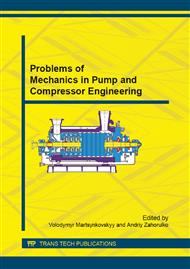[1]
R.D. Arnell, P.B. Davies, J. Halling, T.L. Whomes, Tribology principles and design Application, Springer-Verlag, (1991).
Google Scholar
[2]
L.M. Milne-Thompson, Theoretical hydrodynamics, Macmillan&Co. Ltd., London, (1962).
Google Scholar
[3]
A. Metha, Granular physics, Cambridge university press, New York, (2007).
Google Scholar
[4]
S. Middleman, The flow of high polymers, Interscience publishers a division of John Wiley&Sons, New York, (1970).
Google Scholar
[5]
V.N. Matveenko, E.A. Kirsanov, The viscosity and structure of dispersed systems, Moscow University Chemistry Bulletin, Vol. 66, No. 4 (2011) 199-228.
DOI: 10.3103/s0027131411040079
Google Scholar
[6]
R. Bali, S.K. Sharma, Effect of magnetic field in lubrication of synovial joints, Tribology letters, Vol. 19, No. 4 (2005) 281-287.
DOI: 10.1007/s11249-005-7445-5
Google Scholar
[7]
I. Goryacheva, F. Sadeghi, G. Xu, Viscoelastic effects in lubricated contacts, Wear. 198 (1995) 307-312.
DOI: 10.1016/0043-1648(96)07206-7
Google Scholar
[8]
V. Prokopiev, J. Rogdestvensky, A. Boyarshinova, E. Zadorozhnaya, V. Karavaev, K. Gavrilov, N. Hozenjuk, I. Levanov, Methodology of calculation of dynamics an hydromechanical characteristics complex-loaded tribounits, greased structurally-heterogeneous and non-Newtonian fluids, Proceedings World tribology congress, (2009).
DOI: 10.5772/21564
Google Scholar
[9]
F. Irgens, Rheology and non-Newtonian fluids, Springer, (2014).
Google Scholar
[10]
A. Deshpande, J.M. Krishnan, P.B. Kumar (editors), Rheology of complex fluids, Springer, (2010).
Google Scholar
[11]
Legendre polynomials, Information from Wikipedia – the free encyclopedia http: /en. wikipedia. org/wiki/Legendre_polynomials (accessed on 10 April 2014).
Google Scholar
[12]
L. Savin, E. Kornaeva, Modeling of fluid flow in the cone seal, Procedia Engineering, 39 (2012) 132-139.
DOI: 10.1016/j.proeng.2012.07.017
Google Scholar
[13]
GNU Octave, available online: http: /www. gnu. org/software/octave/ (accessed on 1 October 2013).
Google Scholar
[14]
N.P. Petrov, Friction in machines and effect of the lubrication (in Russian), Inzhenerniy zhurnal, Saint Petersburg. Vol. 1 (1883) 71-140.
Google Scholar
[15]
N.R. Draper, H. Smith, Applied regression analysis, John Wiley&Sons, New York, (1986).
Google Scholar
[16]
A. Lebeck, Parallel sliding load support in the mixed friction regime. Part 2 - Evaluations of the mechanisms, Journal of Tribology, 109 (1987) 196-205.
DOI: 10.1115/1.3261319
Google Scholar
[17]
D.S. Viswanath, T.K. Ghosh, D.H.L. Prasad, N.V.K. Dutt and K.Y. Rany, Viscosity of liquids. Theory, estimation, experiment, and Data, Springer, (2007).
Google Scholar
[18]
A.T. Gorbunov, Elasticoplastic conditions of the filtration of a liquid in porous media, Fluid dynamics, 2 (1975) 38-45.
DOI: 10.1007/bf01023574
Google Scholar


